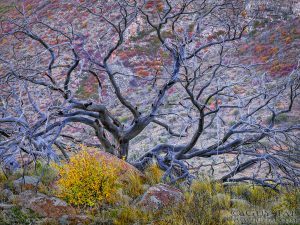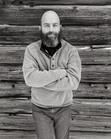Experiences, Not Moments
Under this fine rain I breathe in the innocence of the world. I feel colored by the nuances of infinity. At this moment I am one with my picture. We are an iridescent chaos… ~Paul Cézanne
I recall the satisfying fatigue permeating my body as I arrived at my campsite after wrapping up a workshop. Alone again in the desert, I wandered among the sparse tall grasses surrounding my camp. I felt rewarded to have the world to myself—the comforting views of familiar geology and flora, the wonderful smells of desert plants after the rain, the silence, the breeze on my skin, the play of sunbeams and cloud shadows projected on the giant screen of red cliffs before me, the mind relaxing into solitary normalcy after a few days among people.
And then, a sudden realization. Looking toward the setting sun through the glowing grasses, enchanted by the ethereal glow and the slow rhythmic swaying of the delicate stems, I had, as they say, “a moment.” A vivid memory emerged—a childhood meander in another field, in another life. So complete and visceral was the recollection that for a brief period I was that child again, seeing, thinking, feeling, as I had all those years ago. I was struck by the sense of intense fascination with the world that marked so many of my earliest experiences in the wild. My present self was still there, observing, recalling, and jarred by remembered sensations I have long forgotten I could feel. A grim realization soon emerged—how removed I’ve become from the purity and power of such feelings in the course of becoming an adult.
Surprised, I stopped in my tracks. I wanted to sustain the mix of emotions I have not felt in a long time, and to regain the ability to experience the world with such wonder again as a matter of course. Can I? I felt the sting of tears about to form, and I let them. In the course of seconds, or perhaps minutes, more memories and sensations emerged as I looked into the aura of tiny halos among the grasses. I had lost sense of time. My mind transfixed, enchanted, surprised and overwhelmed by the magnitude of emotions and questions, by the memory of what I was and what I became, and by anxiety and hope for what I may yet become.
But of course, I did not really have a moment. There are no moments. Moments exist in theory alone. To live, to feel, to experience, to think, is to be in a constant state of becoming. It is the dialectic nature of living, and why a living experience cannot be contained in a moment any more than a movie can be contained in a single frame.
Alfred Stieglitz pondered the ability of images to convey faithfully all dimensions of an experience. He referred to this ability as equivalence. He wrote, “What is of greatest importance is to hold the moment, to record something so completely that those who see it will relive an experience of what had been expressed.” Alas, what Stieglitz is describing is only possible to an extent, and not a great one at that. A singular moment cannot contain the richness of an experience. However, a moment of encounter with a photograph may prompt a new experience—the experience of the viewer, rather than that of the photographer.
The viewer may glean, infer, guess, or make up dimensions of the perceived experience based on a momentary impression. If the photographer is skilled in the art of self-expression, the viewer may perhaps even try to relate to the thoughts and sensations expressed, and to assimilate them into subjective sensibilities. But, while sharing some commonalities, the viewer’s experience and the photographer’s experience are never the same. It is the challenge of the expressive photographer to find sufficiently universal metaphors so as to keep the two experiences sufficiently similar in their important details.
But the viewer can never be certain of meanings inferred from visual metaphors. Lacking the specificity of words, visual metaphors are ambiguous by nature. It is precisely this ambiguity that lends photography expressive powers beyond just illustrative ones. It is the quality that liberates photography from the tyranny of objective reality, and that allows photographs to prompt stories of the photographer’s making, rather than the camera’s.
The flow of time cannot be arrested. A moment in itself is meaningless and minuscule—a quanta of experience imperceptible to the senses. This may seem an odd realization for a photographer. Consider some writings on the importance of moments in photography, which may seem in contradiction. For example, Susan Sontag, in her book, On Photography (a scathing critique of the medium), wrote, “All photographs are memento mori. To take a photograph is to participate in another person’s (or thing’s) mortality, vulnerability, mutability. Precisely by slicing out this moment and freezing it, all photographs testify to time’s relentless melt.” She was wrong. To see a photograph is far from participating in another’s story—it is to stop that story and to branch out a new story in which the viewer exists, judges, and brings personal sensibilities and interpretations not shared by the photographer. To freeze a moment is to take that moment out of context, to sever it from the preceding events and from those that will follow—to make irrelevant the passage of time.
Edward Steichen correctly observed, “Photography is a medium of formidable contradictions.” He then explained erroneously, “It [photography] is easy because its technical rudiments can readily be mastered by anyone with a few simple instructions. It is difficult because […] the photographer is the only imagemaker who begins with the picture completed. His emotions, his knowledge, and his native talent are brought into focus and fixed beyond recall the moment the shutter of his camera has closed.” Wrong. After the shutter is closed, there remains a boundless array of creative, expressive possibilities still available to the photographer to influence a viewer’s perception. The photographer may continue to refine, to rethink, and to remake a photograph for years and decades after the film or sensor had been exposed.
There is no moment, at least not in the sense of something representing an experience. There are stories continuously unfolding—the story of the photographer, the stories of the things portrayed, the story of the time in which the photograph was captured, the story of the viewer, the story of the viewer upon seeing the photograph, and so on. Each time the photograph is viewed, all stories converge to a subjective perception in the mind that viewed it. As Sally Mann wrote, “All perception is selection, and all photographs—no matter how objectively journalistic the photographer’s intent—exclude aspects of the moment’s complexity. Photographs economize the truth; they are always moments more or less illusorily abducted from time’s continuum.”
Some consider realism to be photography’s greatest strength, but it is also true that the expectation of realism, in expressive contexts, may be photography’s greatest handicap. The more realistic the photograph, the less expressive it is of the thoughts and personality of the photographer—the things not in front of the lens, not reflecting light, not even having material qualities. This is not to say that photography is incapable of portraying such things, but it is to say that an expressive photograph must be, in the words of Ansel Adams, a “departure from reality.” And I agree completely with another of Adams’s assertions, which is this: “Most creative photographs are departures from reality and it seems to take a higher order of craft to make this departure than to simulate reality.”
What can be easier in photography than to portray things as they are? Conversely, what can be more challenging in photography than to express things of the photographer’s mind—personal and intangible things not detectable by optics and sensitized materials—within the naive expectation of objective, realistic representation? To accomplish such expression within some “decisive moment,” is patently impossible. A decisive moment is either entirely a product of circumstances outside the photographer’s control (and therefore not expressive of the photographer’s mind), or it is an idea arising in the mind of the photographer and that, within the moment, has no tangible qualities perceptible by others. Self-expression cannot be abstracted to that degree. There must be a what, a why, and a how to have experience, and an investment of skill to express it; all amounting to a complex and prolonged succession of moments before the photograph is even perceived by another (who, in turn, will require another sequence of moments to recognize, process, and experience it).
I believe that the fallacy of “freezing a moment” is the reason so many photographers restrict their work to objective representation. Attempting to transcend such objectivism by freezing a moment is an exercise in frustration, and likely also to diminish the very experience the photographer wished to express. An expressive photograph is not the product of a moment, it is a continuity of an experience. To be expressive, the camera should not be considered a scalpel to carve out some moment from reality; it should be considered a means of overlaying reality with subjective meaning—a means of mindfully and deliberately constructing meaning by way of composing skillfully chosen visual metaphors as the experience unfolds.
Moments give rise to experiences. Experiences give rise to life. Life gives rise to art.




